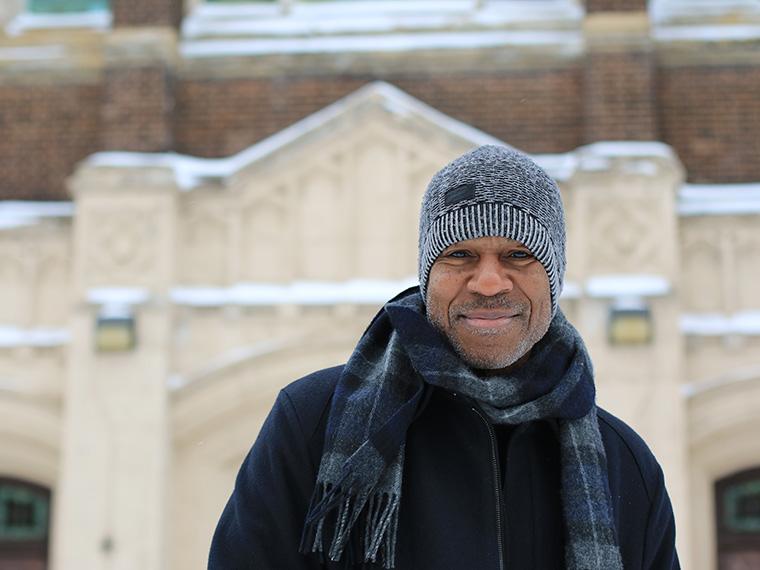Artist Johnny Coleman Finds Inspiration Off the Beaten Path
March 12, 2018
Hillary Hempstead

Johnny Coleman, professor of art and Africana studies, stands in front of a church in Cleveland's Glenville neighborhood.
Photo credit: John Seyfried
Johnny Coleman has a history of casting a wide net to gather inspiration for his work. He’ll continue this approach as one of the six Cleveland-based artists selected to participate in an artist-in-residency program at The Madison as part of FRONT International: Cleveland Triennial for Contemporary Art.
People cautioned Johnny Coleman about going into the swamp at night.
“They looked at me like I was crazy,” said Coleman. But last August, under the cover of darkness and with detailed instructions from locals, Coleman hopped over a barricade leading into Dismal Swamp State Park in North Carolina. The reason for his late night leap? To collect nighttime audio recordings for an upcoming multimedia project about his ancestors who, in the 1700s, lived in the maroon community of freed and escaped slaves in the Great Dismal Swamp.
More often than not, the Young Hunter Professor of Art and Africana Studies, relies on human interaction to lay the groundwork for his artistic projects. Those interactions typically take the form of extended conversations—or, as in North Carolina, careful instructions and a friendly word of warning from folks on the ground—about the topic he is exploring. He’ll visit gathering places and off-the-beaten-path fried fish joints to collect stories and tips. He’s even admitted to approaching individuals right on the street.
“I plant as many seeds as possible,” says Coleman. “I’ve worked this way for 30 years now.”
For another example of Coleman’s artistic process in practice, look no further than his first collaborative artistic venture in Northeast Ohio, back in 1995. At that time, Coleman was invited to participate in a project focused on Cleveland, called Urban Evidence: Contemporary Artists Reveal Cleveland. As a relative newcomer to the area who had recently relocated for his position at Oberlin, Coleman wanted to gain a deeper understanding of the city’s history. So to gather stories from a variety of people, he decided to cast a very wide net.
“I put ads in the Call & Post, a black community newspaper, and in the Plain Dealer,” says Coleman. “I went to barber shops and barbecue joints and put up signs. I would walk the streets in Cleveland’s neighborhoods. People would refer folks to me and, slowly, by word of mouth, people would find me and ask to sit down and talk.”
This organic, but very deliberate, process placed him in conversations with a range of individuals—the oldest aged 102 and the youngest 33 years old—all with diverse life experiences. “They shared so much with me about Cleveland. I really fell in love with the town and the history, and all of it came just from spending time with people, face-to-face.” Coleman notes that since meeting those individuals decades ago, he’s been able to stay in touch with some.
Coleman plans to take a similarly people-centric approach to his next undertaking—an artist-in-residency position for this summer’s FRONT International: Cleveland Triennial for Contemporary Art: An American City, a global art exhibition based in Northeast Ohio that will run from July 14 through September 30, 2018.
As one of the six Cleveland-based artists selected to participate, along with six international and six national artists, Coleman will have the opportunity to live and work in The Madison, a building inside the new PNC Glenville Arts Campus in Cleveland’s Glenville neighborhood.
The Madison, named in honor of the building’s designer and Ohio’s first licensed African American architect Robert P. Madison, once housed black doctors and dentists who could not rent space to practice elsewhere. The building, along with museums including Oberlin's Allen Memorial Art Museum, civic institutions, and other alternative spaces across Northeast Ohio, will display a diverse range of projects, from artist commissions and performances to films and public programs.
The Madison is located virtually around the corner from University Hospitals and the museums and businesses in University Circle. Coleman notes that the Glenville neighborhood is not bustling despite its proximity to populated areas. “Those resources and those investments have not yet trickled down,” says Coleman.
When considering his project’s focus for FRONT, Coleman is committed to staying open to whatever inspires him throughout the neighborhood.
“I’m going to spend many weekends in Glenville so I can gather stories and then share what I discover. I really want to leave it that open-ended. I’m just looking forward to hearing people’s stories and falling into conversations with people over the fence.”
You may also like…
Josh Nolan Named Vice President, General Counsel, and Secretary at Oberlin
Distinguished attorney brings extensive experience in higher education law.
Learning by Teaching: Oberlin Students Share Global Music with Young Learners
College and Conservatory students in PACE 103 prepare local children for an immersive community concert at Oberlin.
Nuiko Wadden ’02 Joins Oberlin Conservatory Faculty as Assistant Professor of Harp
The versatile musician brings extensive opera, orchestral, and contemporary music experience to her role


